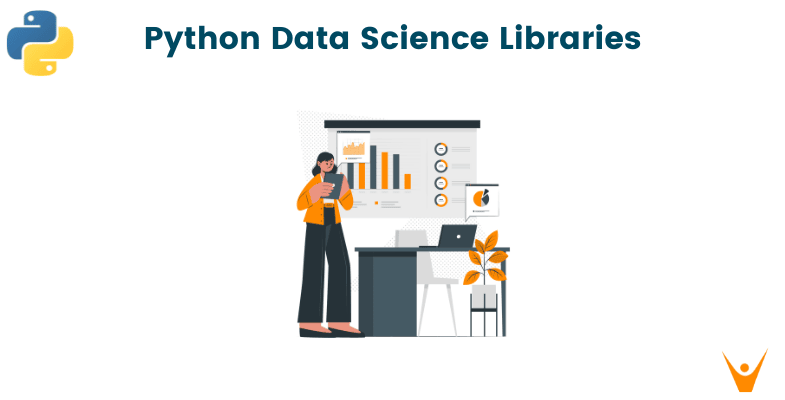Python is a versatile tool that is frequently employed for purposes apart from computer science and analytics. One such use case is for handling data. Today, we will learn about the Top 8 Python Data Science Libraries.
Python Libraries for Data Science
Python is one of the most widely used programming languages in data science. Python has several libraries and tools that make it suitable for data analysis, data visualization, machine learning, and other data-related tasks. Its popularity in data science is partly due to its simplicity and readability, which makes it easy for data scientists to write and maintain code.
Data science involves computational techniques to extract insights from data. On the other hand, a Python library is a collection of pre-written code that provides a set of functionalities that can be used to solve specific programming problems.
There are some python libraries that are useful for data scientists to do Data Manipulation, Machine Learning, Data Visualization, and Statistical Analysis. Libraries like NumPy and pandas offer powerful tools for manipulating data in CSV or Excel. Matplotlib offers charts and plots for visualization.
Some of the main python data libraries are listed below:
- NumPy
- Matbotlib
- Seaborn
- Scikit-learn
- TensorFlow
- Keras
- PyTorch
- Pandas
Let's learn about each of them one by one:
1) NumPy
NumPy is a Python module for numerical computation that can process massive amounts of data and perform array computations. The developers its many functionalities to deal with high-performance multi-dimensional arrays. Compared to Python's looping structures, NumPy matrices offer vectorization of arithmetic computations, which improves efficiency.
It provides a wide range of mathematical functions for performing common operations such as addition, subtraction, multiplication, division, and more. Also, NumPy integrates seamlessly with other libraries commonly used in data science, such as pandas and Matplotlib.
2) Matplotlib
Matbotlib is a visualization-building plotting package that is used to plot graphs and charts. It is frequently utilized for data analysis due to the charts and histograms that it generates. With these charts, you can easily communicate data to a non-technical person.
With this library, you can do Exploratory Data Analysis to identify trends, anomalies, and outliers in the data. Additionally, it offers another OOP interface that can be used to incorporate such visualizations into programs.
x = [5, 2, 7] y = [1, 10, 4] plt.plot(x, y) plt.title('Line graph') plt.ylabel('Y axis') plt.xlabel('X axis') plt.show()
The above code is a simple demonstration of how to display a graph in Python by using matbotlib library. The graph is plotted using both x and y as parameters in the plot function. The graph is given a title using the title function, and the x and y axes are labeled using the label and ylabel functions, respectively.
3) Seaborn
A Matplotlib-based package is used to make visualizations that are more enticing and instructive. With Seaborn, visualization will become a key component of data exploration and comprehension. Seaborn for displaying statistical data. These include themes, color palettes, and custom fonts.
import seaborn as sns import matplotlib.pyplot as plt # Load the iris dataset iris = sns.load_dataset("iris") # Plot a scatter plot of sepal length vs sepal width sns.scatterplot(x="sepal_length", y="sepal_width", data=iris) # Add a title to the plot plt.title("Sepal Length vs Sepal Width") # Show the plot plt.show()
This code will produce a scatter plot of sepal_length vs sepal_width in the iris dataset and is a simple example of the power and ease of use of the Seaborn library for data visualization.
4) Scikit-learn
Scikit-learn is a machine learning package for Python that offers practical tools for data analysis and mining. It is useful for data processing, classification, regression, and clustering.
import numpy as np from sklearn import datasets from sklearn.model_selection import train_test_split from sklearn.neighbors import KNeighborsClassifier # Load the iris dataset iris = datasets.load_iris() # Split the data into training and testing sets X_train, X_test, y_train, y_test = train_test_split(iris.data, iris.target, test_size=0.2, random_state=42) # Train a K-nearest neighbors classifier on the training data knn = KNeighborsClassifier(n_neighbors=5) knn.fit(X_train, y_train) # Evaluate the classifier on the testing data accuracy = knn.score(X_test, y_test) print("Accuracy: {:.2f}%".format(accuracy * 100))
The K-nearest neighbors classifier accuracy on the iris dataset will be output by the code, which is a straightforward illustration of utilizing sci-kit-learn for a supervised learning problem.
5) TensorFlow
An open-source software framework created by Google called TensorFlow enables dataflow and differentiable programming for a variety of purposes, including machine learning. It also provides many abstraction levels enabling users to decide on the appropriate strategy for a particular concept.
One could also use TensorFlow to run ML algorithms and models across a variety of platforms, including an individual's smartphones, the internet, and the cloud.
6) Keras
Keras is a Python-based high-level neural network API that can operate on top of TensorFlow, CNTK, or Theano. It was created with the goal of allowing for quick experimentation. Keras, being a user-friendly, modular, and extensible toolkit, makes it simple to create deep learning models.
This allows you to create, compile, and train neural networks with just a few lines of code. It supports neural network layers, activation functions, loss functions, and optimizers that are typical in neural networks.
7) PyTorch
Based on the Torch library, PyTorch is an open-source machine learning library used for tasks like computer vision and natural language processing. It was created by Facebook's AI research team and is extensively used in both business and academia.
PyTorch offers a dynamic computational graph that enables instant computations, debugging, and a simple transition from research to production. It also offers a flexible, intuitive interface for creating and training deep learning models. Furthermore, PyTorch supports distributed computation, enabling quick and effective model training on huge datasets.
8) Pandas
Is pandas a data science library? Yes, Pandas is a popular data science library. It provides a range of functions for data manipulation, data analysis, and data visualization, making it a valuable tool for data scientists.
This library is used for processing and manipulating data sets. It is widely used for information preprocessing and munging.
import pandas as pd # Create two pandas Series s1 = pd.Series([1, 2, 3, 4, 5]) s2 = pd.Series([6, 7, 8, 9, 10]) # Perform element-wise addition result = s1 + s2 print("Addition result:", result) # Create two pandas DataFrames df1 = pd.DataFrame({'A': [1, 2, 3], 'B': [4, 5, 6]}) df2 = pd.DataFrame({'A': [6, 7, 8], 'B': [9, 10, 11]}) # Perform element-wise addition result = df1 + df2 print("DataFrame addition result:\n", result)
The pandas library is one of the most essential things you will learn in any Data Science Course and it acts as a starting point for many tasks in the real programming world.
9) Statsmodels
Statsmodelslibrary provides a range of statistical models as well as tools for data scientists. The models include linear and logistic regression or generalized linear models. It also easily integrates seamlessly with Pandas, to analyze and visualize data stored in data frames.
10) NLTK
NLTK or Natural Language Toolkit is used for natural language processing. Some data scientists deal with the analysis of natural language data. It provides a range of functions for text processing. It also offers functions for sentiment analysis, which is the process of determining the sentiment or opinion expressed in a piece of text.
Overall, there are many python packages for data science. But there are also some libraries that are not so useful.
Which Python library is not used for data science? One example is PyGame which is designed for game development. It has no applications in analyzing data.
Also, check some good data science projects for beginners to practically test your skills.
Conclusion
Python is the most often used coding language required in data science professions and now you also know the best python libraries for data science including NumPy, Pandas, PyTorch, etc. Happy Learning :)








